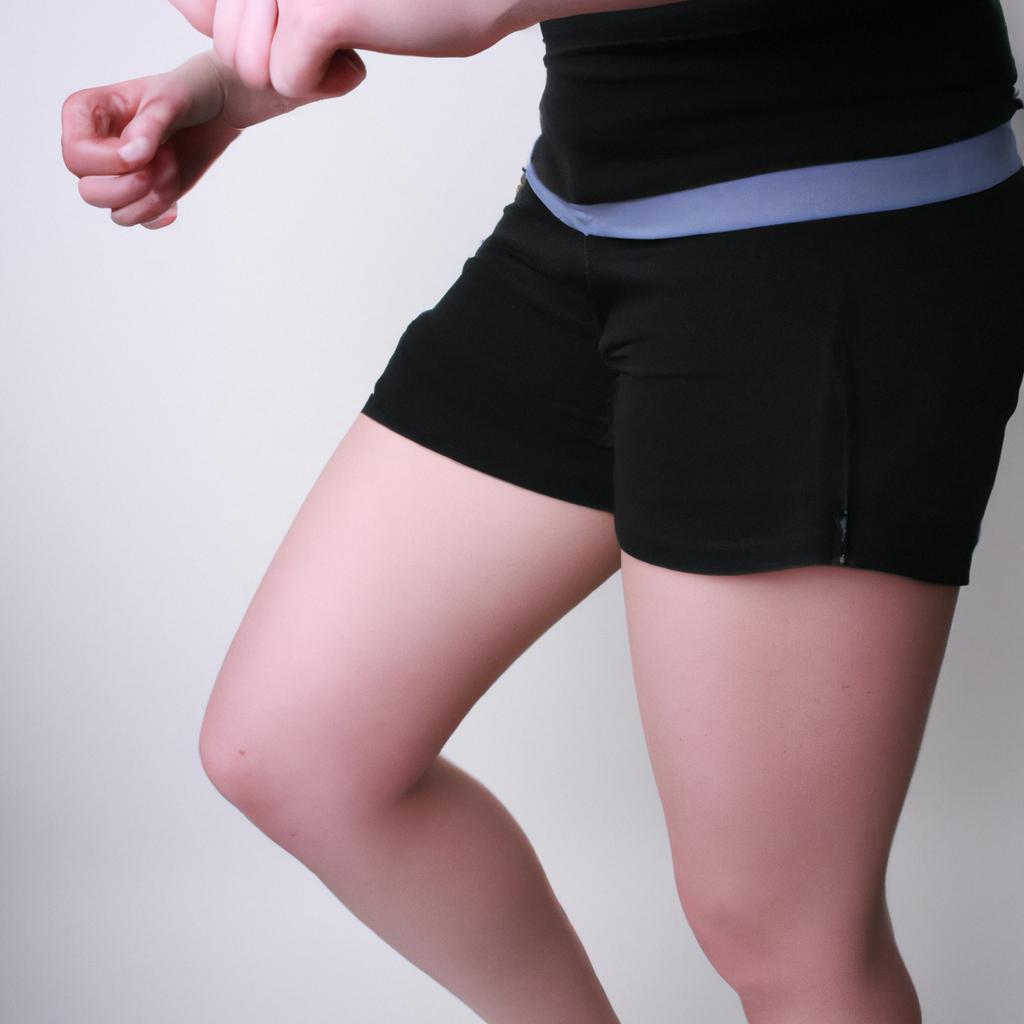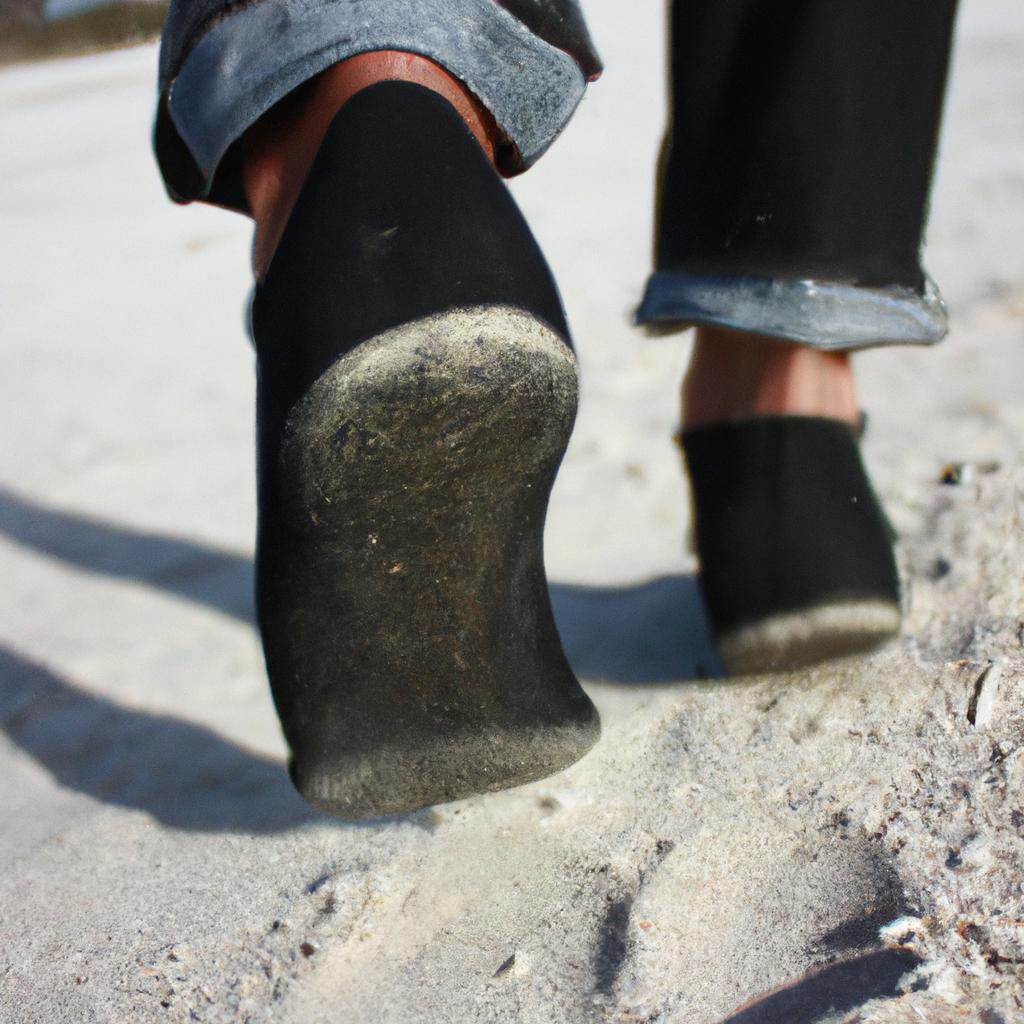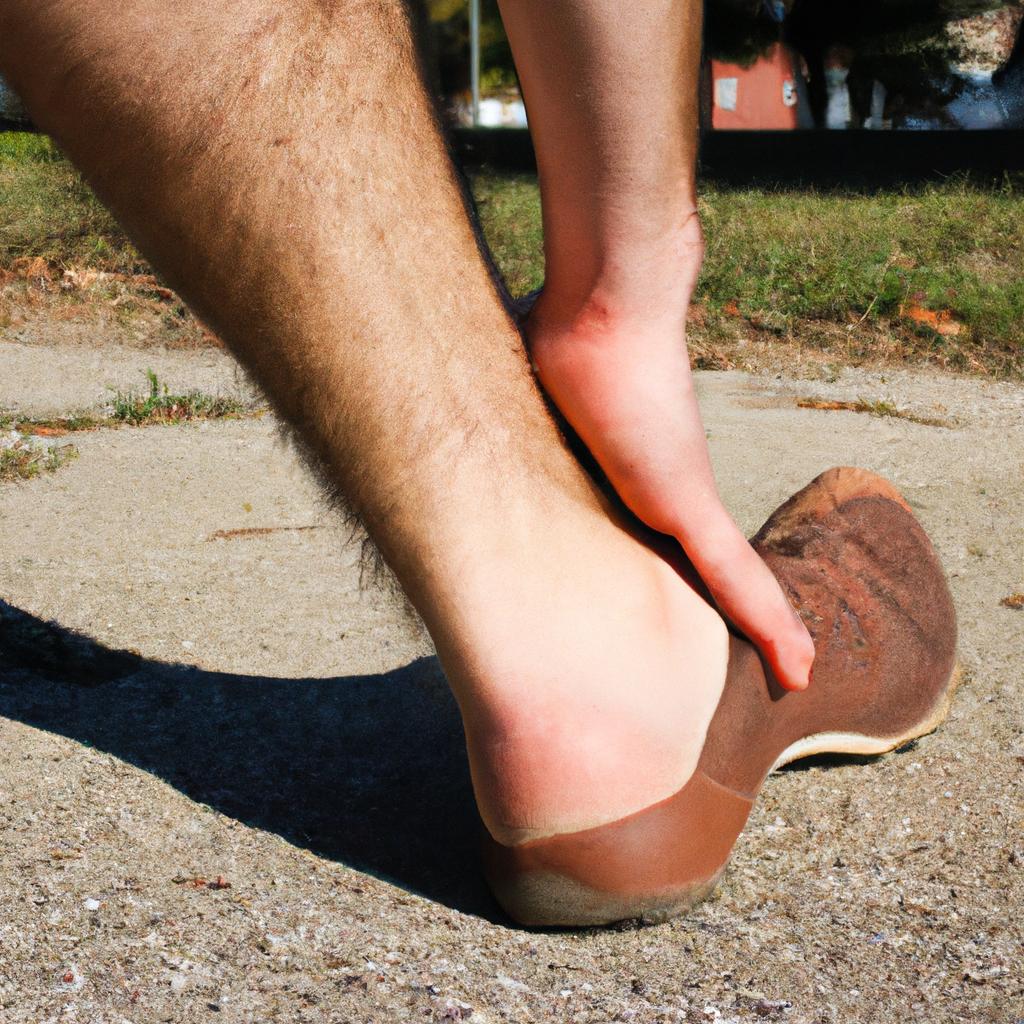Pelvic tilt is a crucial aspect of the human body’s biomechanics, and it plays an essential role in stabilizing the spine during movement. It refers to the anterior/posterior orientation of the pelvis in relation to the femurs and is influenced by various factors such as muscle imbalances, joint stiffness, or structural abnormalities.
For instance, let us consider a hypothetical case study where Jane, a 35-year-old woman with lower back pain for six months, visits her physiotherapist. During her assessment, the physiotherapist observes that Jane has excessive anterior pelvic tilt when standing upright. This observation leads to further examination of Jane’s gait analysis, which revealed asymmetrical weight distribution and overpronation on her left foot. Based on these findings, they develop a treatment plan including specific exercises to correct her pelvic alignment and address any contributing factors like weak gluteal muscles or tight hip flexors.
In this article, we will explore different aspects of assessing pelvic tilt from both clinical and research perspectives. We will discuss its significance in evaluating musculoskeletal dysfunctions related to low back pain and other conditions affecting gait mechanics. Furthermore, we will provide insights into common methods used for measuring pelvic tilt angles along with their limitations and discuss the importance of considering individual variability and functional outcomes in interpreting these measurements. Overall, understanding pelvic tilt is essential for clinicians working with patients experiencing musculoskeletal pain or dysfunction and can aid in developing effective treatment plans to improve their quality of life.
Understanding Pelvic Tilt
Pelvic tilt refers to the orientation of the pelvis in relation to the spine. It is an essential component of body posture that influences movement patterns and plays a crucial role in gait analysis and physiotherapy examination. For instance, individuals with excessive anterior or posterior pelvic tilts may experience pain, discomfort, and poor functional performance during daily activities.
To better understand pelvic tilt, consider a hypothetical situation where a patient presents at a physiotherapy clinic complaining of low back pain. Upon assessment, it is discovered that they have an exaggerated anterior pelvic tilt. This means that their pelvis is rotated forward relative to their spine resulting in increased lumbar lordosis (curvature). The exaggerated curvature places undue stress on the lower back muscles leading to strain and eventual pain.
There are four main types of pelvic tilts: anterior pelvic tilt, posterior pelvic tilt, lateral pelvic tilt, and rotational pelvic tilt. An individual’s type of pelvic tilt can determine which muscles are overactive or underactive leading to muscle imbalances. These imbalances often lead to compensatory movements affecting other parts of the body causing further injuries.
The effects of misaligned pelvis go beyond physical pain; they also impact people emotionally as well as socially. In fact, changes in posture due to abnormal pelvic alignment affect how others perceive an individual’s confidence level based on nonverbal communication cues like eye contact and facial expressions.
It is important for healthcare professionals such as chiropractors and physiotherapists to assess patients’ postural abnormalities accurately through palpation tests or imaging techniques before recommending treatment options . Additionally, determining whether there are any underlying medical conditions such as osteoporosis or scoliosis must be done before prescribing exercises aimed at correcting faulty postures.
In summary, understanding different types of pelvic tilts forms a fundamental aspect of assessing musculoskeletal disorders such as low back pain. It enables healthcare professionals to develop targeted interventions aimed at correcting muscle imbalances and postural abnormalities, ultimately improving patients’ functional performance in daily activities. The following section will discuss the importance of pelvic tilt in physiotherapy examination and gait analysis.
The Importance of Pelvic Tilt in Physiotherapy
Understanding how pelvic tilt affects the body is vital in physiotherapy. For instance, a patient who comes with lower back pain and limited hip mobility can have an anterior pelvic tilt that requires correction to reduce their symptoms.
One significant reason why examining pelvic tilt is crucial during gait analysis or physio assessment is that it impacts balance and posture. Pelvic tilts can cause misalignment of different structures of the spine, leading to muscle imbalances, joint dysfunction, and pain. Notably, research indicates that reduced posterior pelvic tilt causes increased lumbar lordosis and may contribute to low back pain .
Another importance of assessing pelvic tilt is for treatment planning. Understanding the degree and direction of pelvic tilt enables clinicians to design specific rehabilitation programs targeting weak muscles while avoiding overuse injuries on already strained ones. The following bullet points summarize why assessing pelvic tilt is essential:
- Helps diagnose postural problems
- Identifies faulty movement patterns
- Prevents future musculoskeletal issues
- Enhances recovery from current injuries
Table 1 below shows some common compensatory strategies used by individuals with abnormal anterior and posterior pelvis tilts.
| Pelvic Tilt | Compensatory Strategies | Implications |
|---|---|---|
| Anterior | Increased Lumbar Extension | Hip Flexor Tightness; Low Back Pain |
| Posterior Rotation Of Upper Body Towards Affected Side | Asymmetrical Gait Patterns | |
| Flexion Of Knees And Ankles When Standing | Misaligned Center of Mass | |
| Posterior | Decreased Lumbar Lordosis | Flat Back Posture |
| Forward Head Posture | Cervical Spine Dysfunction | |
| Hyperextension Of Hips | Muscle Imbalance |
The above table illustrates how different types of malalignments affect the body’s different structures, leading to various compensatory strategies. These ultimately lead to further musculoskeletal issues and hinder proper movement patterns.
In conclusion, assessing pelvic tilt is a crucial element in physiotherapy examination and gait analysis. It helps identify muscle imbalances, faulty movements, postural problems and enhances recovery from current injuries while preventing future ones.
Common Causes of Pelvic Tilt Imbalances
The Importance of Pelvic Tilt in Physiotherapy emphasizes the need for a thorough understanding and assessment of pelvic tilt imbalances. In this section, we will delve deeper into common causes of pelvic tilt issues.
Let’s consider an example: John has been experiencing low back pain for several months, and his physiotherapist suspects it may be due to a pelvic tilt imbalance. After conducting a gait analysis, his therapist determines that there is indeed an anterior pelvic tilt present. The therapist then proceeds to identify potential causes and develop an appropriate treatment plan tailored to John’s specific needs.
There are many possible reasons why someone may have a pelvic tilt imbalance. These can include:
- Muscle imbalances or weakness
- Poor posture habits
- Pregnancy
- Previous injuries or surgeries
It is essential to address these underlying factors as part of any successful treatment plan aimed at reducing pain and improving function.
Research has shown that addressing pelvic tilt issues through physiotherapy interventions such as targeted exercise programs can lead to significant improvements in symptoms . Here’s how:
| Intervention | Benefits |
|---|---|
| Stretching tight muscles | Increases flexibility and reduces tension |
| Strengthening weak muscles | Improves stability and balances muscle tone |
| Postural retraining | Corrects poor habits and improves alignment |
| Manual therapy techniques (e.g., massage) | Reduces muscle tension and promotes relaxation |
By identifying the root cause(s) of patients’ pelvic tilt imbalances, practitioners can design effective treatment plans that target their unique needs. This approach not only helps alleviate current symptoms but also prevents future injury recurrence.
In summary, assessing common causes of pelvic tilt imbalances plays a crucial role in designing effective physiotherapy interventions. An individualized approach focused on identifying specific contributing factors can help reduce pain levels while improving overall function .
Next, we will discuss the various symptoms and signs of pelvic tilt issues, providing further insight into how these imbalances can manifest in different ways.
Symptoms and Signs of Pelvic Tilt Issues
Common causes of pelvic tilt imbalances can lead to a variety of symptoms and signs that may affect an individual’s daily life. For example, imagine a person who has been sitting for extended periods with their legs crossed for several years. This habit could cause one hip to be higher than the other, resulting in pelvic tilt imbalance. As this issue progresses, it may lead to severe back pain and difficulty walking.
Pelvic tilt issues can also arise from poor posture or injury. When the pelvis is not correctly aligned, it affects the entire body’s biomechanics and can create compensations in other areas such as the knees or ankles. The following bullet points highlight some common effects of pelvic tilt:
- Chronic lower back pain
- Hip discomfort
- Knee osteoarthritis
- Poor gait mechanics
A study conducted by found that there is a correlation between changes in pelvic alignment and increased knee joint stress during activities like running or squatting. Additionally, another research suggests that individuals with anterior pelvic tilt have less ankle range of motion compared to those without any spinal abnormalities.
The severity of symptoms caused by pelvic tilt varies depending on each case’s unique circumstances; however, certain physical indications are commonly associated with these imbalances. These include uneven hips, asymmetrical leg length, muscle stiffness/tightness around the hips/lower back area, among others.
To better understand how to identify these indicators accurately, healthcare practitioners use various assessments techniques while examining patients affected by pelvic tilt issues. In subsequent sections we will delve into different methods used to assess pelvic tilt reliably.
| Gender | Age Range | Symptoms |
|---|---|---|
| Male | 30 – 40 | Lower Back Pain & Stiffness |
| Female | 45 – 55 | Knee Osteoarthritis & Hip Discomfort |
| Male | 20 – 25 | Poor Gait Mechanics & Hip Pain |
In conclusion, pelvic tilt imbalances can cause a range of symptoms and signs that can significantly impact an individual’s quality of life. As such, it is crucial for healthcare practitioners to identify these issues accurately through proper assessment techniques.
Assessment Techniques for Pelvic Tilt
Symptoms and Signs of Pelvic Tilt Issues highlighted the various indicators of pelvic tilt dysfunction. To further understand and address this problem, it is crucial to evaluate the patient’s condition using appropriate assessment techniques.
For instance, in a case study involving a 35-year-old male athlete complaining of lower back pain after intense physical activity, assessing his pelvic tilt would be necessary. During examination, the therapist observed that one side of his pelvis appeared higher than the other. The patient also reported experiencing hip discomfort when standing for prolonged periods or running on uneven surfaces.
To assess pelvic tilt accurately, therapists use several techniques such as visual observation, palpation, gait analysis . Visual inspection involves analyzing the alignment of anatomical landmarks like iliac crests and pubic symphysis. Palpation entails feeling muscle tension around the lumbar spine and identifying any asymmetry or misalignments. Gait analysis evaluates how patients walk and run while observing their posture carefully.
Assessing pelvic tilt provides insight into its severity and guides treatment plans. Here are some benefits:
- Identifying underlying causes: Evaluating pelvic tilt can help determine if it results from poor posture habits or an injury.
- Prevention: Early detection through assessments increases chances of preventing severe complications such as chronic low back pain.
- Monitoring progress: Regular evaluation helps track changes in pelvic alignment during treatment
- Customized therapy plan development: With accurate assessments, therapists create tailored interventions unique to each patient’s needs
Furthermore, documenting assessments findings is essential for future reference by healthcare professionals involved in treating the same patient. Below is an example table outlining different types of pelvic tilts with their effects on body mechanics.
| Type | Effects |
|---|---|
| Anterior Pelvic Tilt | Increased Lumbar Lordosis (swayback), tight Hip Flexors |
| Posterior Pelvic Tilt | Decreased Lumbar Lordosis (flat back), tight Hamstrings |
| Lateral Pelvic Tilt | Uneven Hip Height, Leg length discrepancy |
| Rotation/Obliquity | One side of the pelvis higher than the other |
Assessing pelvic tilt is an essential element in physiotherapy examinations and gait analysis. It helps identify underlying causes, prevent complications, monitor progress, and develop customized therapy plans unique to patient needs. Therefore, healthcare professionals should prioritize appropriate assessments for patients with suspected pelvic tilt issues.
The next section will discuss Effective Pelvic Tilt Correction Strategies without using “step” phrases or words like “now.”
Effective Pelvic Tilt Correction Strategies
In this section, we will be discussing Effective Pelvic Tilt Correction Strategies.
Let’s take an example of a patient who has anterior pelvic tilt due to prolonged sitting. The patient complains of lower back pain and difficulty in walking long distances. The physiotherapist performs various tests and finds that the patient has weak glutes and tight hip flexors contributing to his condition.
Here are some effective correction strategies that can help alleviate this patient’s symptoms:
- Strengthening exercises: Targeted exercises such as squats, lunges, bridges, and deadlifts can help strengthen the glutes, hamstrings, and core muscles, which play an essential role in stabilizing the pelvis.
- Stretching exercises: Tight hip flexors need to be stretched regularly to maintain flexibility. Psoas stretch, quad stretch, butterfly stretch are all great options.
- Postural awareness training: Patients with pelvic tilt often have poor posture habits that contribute to their condition. Educating them on proper alignment while standing, sitting or lying down is crucial.
- Ergonomic modifications: Adjustments to workstations or seating arrangements can reduce pressure on the lower back by promoting better postures.
To further illustrate these strategies’ effectiveness let’s look at a table showcasing how different interventions impact patients with pelvic tilt.
| Intervention | Results |
|---|---|
| Exercise Therapy | Improved muscle strength and reduced pain |
| Myofascial release therapy | Reduced tension in tight muscles |
| Chiropractic manipulation | Immediate relief from pain but limited evidence for long-term benefits |
| Acupuncture | Limited evidence for its effectiveness |
As you can see from the table above, exercise therapy and myofascial release therapy show promising results compared to other interventions like chiropractic manipulation or acupuncture.
In conclusion, correcting pelvic tilt involves a multifaceted approach that includes exercises, stretching, postural awareness training, and ergonomic modifications. Effective implementation of these strategies can help alleviate pain and improve mobility in patients with pelvic tilt.




